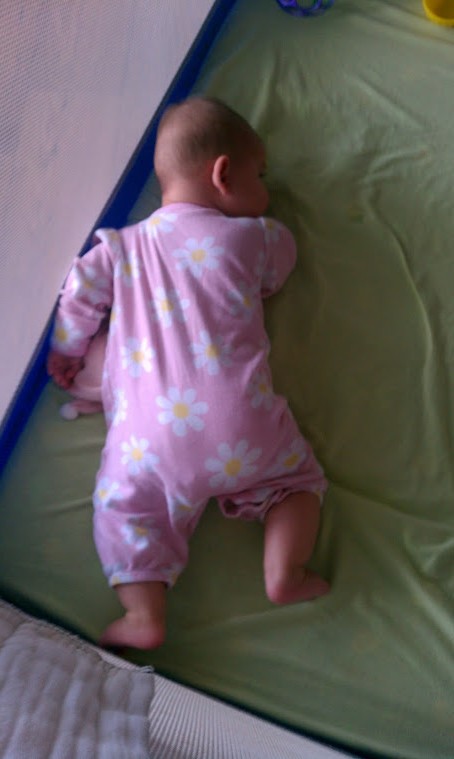Natural, unassisted gross motor development means waiting for baby to choose tummy time. This is how it happens, or at least how it’s happening here…
One day before her 5 month birthday, R. turned onto her tummy all by herself. She was startled and didn’t like it much, and immediately let out a loud wail. After acknowledging what she had accomplished, “You turned onto your tummy!”, I told her I was going to pick her up, and after a bit of cuddling, I placed her down in her play space on her back, where she contentedly continued to play for another hour.
She chose not to return to the tummy position for almost a full month afterwards. She would play on her back, finding her toys, bringing them to mid-line, and her mouth, and she also did quite a bit of playing while lying on her side, but she stopped short of turning onto her tummy.
Then one day, about a month later, she DID turn onto her tummy, and while it was clear to me that she was “ready” for this experience, as evidenced by the fact that she could lift her head and look around easily in this position, as well as support herself on her forearms, and reach and grab for toys, she was STILL clear she did not like it, and was uncomfortable.
I continued to put her on her back for play, and let her choose, and about two weeks ago, even though she never again turned onto her tummy during play time while awake, she started turning onto her tummy when she was in her crib, asleep. The change in position would inevitably wake her, and she’d cry out to me in distress.
I responded by going to her and acknowledging, “You turned onto your tummy, and you woke up. I am going to pick you up, and put you down on your back, so you can rest.” She would sigh and stretch out and go back to sleep, although I often didn’t! This cycle repeated itself 5 or 6 times a night.
For the past three nights, R. has continued to turn herself over in her sleep, and each time, she cries out briefly, but then immediately goes back to sleep on her own, still on her tummy. Here is how I find her when I go in to greet her in the morning:
Today, one day shy of her 7 month birthday, she has been on a nap strike. She is clearly tired, and seems happy to be in her crib, but shortly after I leave the room, she cries out insistently, and when I respond, I find she is on her tummy, and often has moved a full 180 degrees from the position she was originally in.
She grins when she sees me, and I tell her (after a few minutes of observing her and talking with her), that I am going to pick her up, place her on her back, and let her rest. We have repeated this cycle about ten times so far today. In between NOT napping, I feed her and change her diaper, and we enjoy this slow, connected, time together, and then she plays contentedly on her back for short periods in her play space.
R. has not yet figured out how to (or that she can) turn from her tummy to her back on her own, so she needs my support right now. I see my role as listening to her, acknowledging her, reassuring her, and re-positioning her when she tells me she is too uncomfortable, and doesn’t know how to turn back on her own. Most of all, I view my role as trusting her, trusting her process, trusting her timing, and trusting that she is going to figure this out for herself in her own time, if I just wait and offer her the right amount of support.
Is it easy for either of us? No. There is struggle. There is frustration. There is disruption in sleep. There is complaining (on both our parts). Would I do it any other way, or change anything if I could? Not a thing.
R. is learning to learn. She is learning that she is in charge of her own body and her own process. She is learning to trust herself. She is learning to trust me. I am learning to trust her. She is learning that SHE is in control, and that she can move one way, and then another way, if she is not comfortable. And she’s learning that she’s not alone in this, no matter how difficult or uncomfortable it may be for her right now. These are lessons that will serve her well throughout her life.
If you have no idea what I’m talking about and you are curious to learn more, or if you have an idea of what I’m talking about, and still want to learn more, I can do no better than to refer you to Janet Lansbury’s site, elevating childcare, for she (and Magda Gerber before her) has been my truest and most trusted guide, mentor, friend, and teacher.


